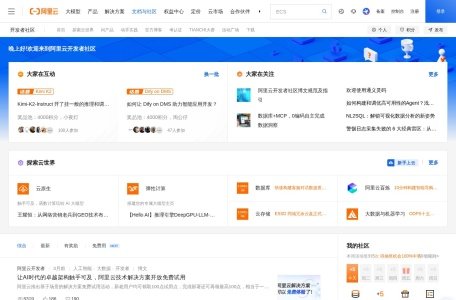
“Should I learn math or Python first for AI?” “Spend 3 days setting up a GPU environment, only to get errors after 5 minutes of model training?” “Master theory but still can’t build a simple recommendation system?” These are the top frustrations for 80% of AI beginners. But the Alibaba Cloud AI Learning Path – developed by Alibaba Cloud Developer Community – has transformed “AI mastery” from a year-long struggle into a 3–6 month journey, thanks to its “5-stage progressive structure + cloud-based hands-on labs + certification validation.” As of 2025, over 500,000 learners have built AI skills through this path, with 62% of ACA/ACP certificate holders securing salary hikes or career transitions. This article breaks down why it’s the “go-to choice for zero-basis AI learners,” using the latest curriculum details and real learner stories.
I. What Is the Alibaba Cloud AI Learning Path? Positioning & Core Value
The Alibaba Cloud AI Learning Path is not a random collection of courses – it’s a closed-loop AI skill-development system rooted in Alibaba’s tech ecosystem. Unlike “theory-heavy” platforms, its core strengths lie in three pillars:
- Ecosystem Integration: Direct access to Alibaba Cloud PAI (Platform for Artificial Intelligence) and Tianchi (Data Science Community) – no local GPU setup needed; just use a browser to run models;
- Project-Driven Learning: 22 hands-on projects based on real scenarios (e.g., simplified Taobao recommendation systems, medical image recognition) – skills learned here apply directly to work;
- Certification Alignment: Completing stages prepares learners for Alibaba Cloud ACA/ACP certifications, recognized by ByteDance, Huawei, and Alibaba Group – a “career passport” for AI roles.
A former IT engineer in traditional industries shared: “I used to get stuck on environment setup when self-learning AI. With Alibaba Cloud’s path, I finished my first ‘customer churn prediction’ project in 3 days using the PAI platform – it saved me so much time.”
II. Core Curriculum Breakdown: 5 Stages From “Theory” to “Deployment”
The Alibaba Cloud AI Learning Path is structured by “foundation → frameworks → hands-on practice → vertical domains,” with every stage including “video lectures + documentation + code samples + online labs” to avoid “learn-and-forget” pitfalls:
1. Stage 1: Machine Learning Fundamentals (3 Courses, 128 Hours) – Build the Base
Prerequisites: Basic Python (loops, Pandas) + high school math (linear algebra, probability)
Key Content:
- Machine Learning Overview & Common Algorithms: Explains clustering via “e-commerce product categorization” and linear regression through “housing price prediction.” Avoids complex formulas; focuses on “what problems each algorithm solves”;
- Detailed Machine Learning Algorithms: Breaks down use cases for 10+ algorithms (decision trees, random forests, SVM) – e.g., “logistic regression for credit scoring, K-Means for user segmentation”;
- Neural Network Basics: Uses “multi-layer neurons simulating human decision-making” to explain CNN/RNN fundamentals. Includes a “handwritten digit recognition” lab – build a simple neural network on PAI with drag-and-drop tools.
Outcome: Understand AI project architectures; implement basic algorithms with Scikit-Learn.
2. Stage 2: TensorFlow Framework Mastery (4 Courses, 78 Hours) – Master the Tool
Prerequisites: Basic algorithms + basic English (for framework docs)
Key Content:
- TensorFlow Fundamentals: Covers “tensor creation” to “model saving,” with step-by-step PAI demos (e.g., loading Tianchi’s “Titanic dataset” with TensorFlow);
- NumPy/Pandas/Matplotlib Practicum: Solves real data challenges – e.g., “handling missing values with Pandas,” “plotting feature correlation heatmaps with Matplotlib”;
- TensorFlow Advanced: Model Optimization: Teaches “learning rate tuning to avoid overfitting” and “early stopping to save training time.” Includes an “Iris classification optimization” lab to compare parameter effects.
Outcome: Build and train simple models independently with TensorFlow; troubleshoot common training issues.
3. Stage 3: Machine Learning Practicum (9 Courses, 94 Hours) – From “Learn” to “Do”
Highlight: 9 business-scenario projects using real Tianchi datasets:
- Recommendation System Project: Build a “You May Also Like” feature (like Taobao’s) using collaborative filtering. Complete the full workflow: “data cleaning → feature engineering → model deployment” on PAI;
- News Classification Project: Use TF-IDF for text feature extraction + logistic regression to classify news into “sports/finance/technology.” Master text data processing skills;
- Temperature Forecasting Project: Use time-series ARIMA to predict 7-day temperatures. Learn to handle “trends and seasonality in time-series data.”
Outcome: Complete small-to-medium ML projects independently; add “deployable project experience” to your resume.
4. Stage 4: NLP Practicum (7 Courses, 67 Hours) – Vertical Specialization
Key Content: Focus on high-demand NLP scenarios to avoid “learning niche skills”:
- Text Classification & Sentiment Analysis: Use BERT to analyze positive/negative e-commerce reviews. Learn to leverage pre-trained models to save development time;
- Chatbot Project: Build a simple “customer service bot” that responds to “logistics inquiries” with tracking links. Understand intent recognition basics;
- Machine Translation Basics: Implement simple “English-Chinese translation” with Seq2Seq models. Learn the “encoder-decoder” workflow in NLP.
Practical Case: Simplified version of Tianchi’s “Financial Text Risk Detection Competition” – identify fraudulent loan applications using NLP.
5. Stage 5: Computer Vision (CV) Practicum (7 Courses, 57 Hours) – Another Vertical Track
Key Content: Progressive learning from tools to applications:
- OpenCV Fundamentals: Teach “image cropping, grayscaling, edge detection” – e.g., process license plate images to extract character regions;
- CNN Image Recognition Project: Build a “cat/dog classifier” with CNN. Learn data augmentation (rotating/flipping images) to solve small-dataset issues;
- Object Detection Project: Use YOLO to detect faces in images. Annotate face positions in real time on PAI; understand “difference between image classification and object detection.”
Practical Case: “CAPTCHA Recognition Project” – automatically identify numbers/letters in website CAPTCHAs. Master CV for automation scenarios.
III. Core Advantages: 4 “Irreplaceable” Traits
1. Cloud-Based Lab Environment: No Setup – Direct GPU Access
No need to install Anaconda or configure CUDA – just use Alibaba Cloud PAI:
- Free Quota: New users get 10 hours of free Tesla T4 GPU monthly (a CNN model takes only 20 minutes to run);
- Visual Interface: Build model workflows with drag-and-drop tools (e.g., “data input → feature engineering → training → output”) – easy for beginners;
- One-Click Replication: Each lab has a “copy project” button to reuse instructors’ code/parameters – avoid “environment-related delays.”
A university student shared: “I spent 2 days setting up TensorFlow locally and still got errors. With Alibaba Cloud’s ready-to-use environment, my first model ran successfully on the first try – it gave me so much confidence.”
2. Tianchi’s Real-World Ecosystem: Authentic Data + Scenarios
All project datasets come from Alibaba Cloud Tianchi, matching enterprise data formats:
- E-commerce: Taobao user behavior data, Tmall product review data;
- Finance: Credit risk assessment data, stock market data;
- Healthcare: De-identified chest X-ray data.
After learning, join Tianchi’s “beginner competitions” (e.g., “Housing Price Prediction Contest”) to build project experience.
3. Certification System: Turn Skills Into Career Credibility
The learning path is tightly linked to Alibaba Cloud ACA/ACP certifications:
- Stages 1–3 Completed: Eligible for “Alibaba Cloud ACA AI Engineer” (entry-level, ideal for beginners);
- Stages 4–5 Completed: Eligible for “Alibaba Cloud ACP Senior AI Engineer” (practical, a “plus” for top companies).
Exams include “theory + hands-on tasks” – the practical section requires completing a project on PAI (e.g., “train and deploy a classification model with given data”), mirroring real work. An AI company HR noted: “We prioritize candidates with Alibaba Cloud ACP – it proves they have hands-on skills.”
4. Community Support: Questions Answered Within Hours
Access Alibaba Cloud Developer Forum with two key support channels:
- Technical Q&A: Post questions like “How to fix overfitting?” or “PAI platform error troubleshooting” – average response time is 1 hour, with answers often from Alibaba engineers;
- Resource Sharing: Users share “certification study notes” and “project optimization tips” – e.g., a popular “TensorFlow API Cheat Sheet”;
- Live Q&A: Weekly free live sessions where instructors explain course难点 and review student projects.
IV. Target Audience: Who Should Learn This Path?
1. Zero-Basis Beginners (Students/Career Changers)
- Recommended Path: Start with Stage 1; finish Stages 1–3 in 6 months; take the ACA exam first;
- Goal: Master ML basics; build simple projects (e.g., user segmentation, sales forecasting); qualify for entry-level roles like Data Analyst or AI Assistant Engineer.
2. Working Developers (Programmers/Data Analysts)
- Recommended Path: Start with Stage 2 if you know Python; finish Stages 2–4 in 3 months; take the ACP exam;
- Goal: Build NLP projects independently (e.g., sentiment analysis, chatbots); transition to roles like AI Algorithm Engineer or NLP Engineer.
3. Traditional Industry Transitioners (Manufacturing/Retail/Healthcare)
- Recommended Path: Choose vertical stages based on your industry – e.g., manufacturing (Stage 5 for CV-based equipment fault detection), retail (Stage 3 for recommendation systems);
- Goal: Solve industry-specific problems – e.g., “predict equipment failures with ML” or “use CV to track retail inventory.”
V. Learning Guide: 3 Steps to Maximize Efficiency
1. Preparations (1 Week)
- 补Python Basics: Take Alibaba Cloud’s supplementary “Python Learning Path” – focus on Pandas data processing;
- Register: Visit the Alibaba Cloud AI Learning Path page (Developer Community section); complete identity verification to claim free GPU quota.
2. Learning Rhythm (By Stage)
- Stages 1–2: 1.5 hours/day, finish in 2 months – prioritize fundamentals; don’t rush;
- Stage 3: 2 hours/day, finish in 1.5 months – complete each project twice (follow instructions first, then build independently);
- Stages 4–5: Choose one vertical track (NLP/CV); finish in 1.5 months – build a full project (e.g., “customer service bot” or “face check-in system”) for your portfolio.
3. Pitfall Avoidance
- Don’t just watch videos: Do labs after every lesson – “hands-on practice” is key to retention;
- Don’t take exams unprepared: Use forum “study notes” and official mock tests (available on Alibaba Cloud);
- Don’t hesitate to ask for help: Post questions early – community support saves time.
Conclusion: The “Cost-Effective Choice” for AI Learning
The Alibaba Cloud AI Learning Path’s essence is “breaking down enterprise AI workflows into learner-friendly steps”:
- Cloud labs solve “setup pain”;
- Real datasets bridge “theory-practice gaps”;
- Certifications validate “skill credibility.”
For learners serious about AI (not just “trend-chasing”), it’s a highly cost-effective option. If you’re stuck on “what to learn, how to learn, or how to prove your skills,” start with Stage 1’s Machine Learning Overview – experience the “learn-by-building” difference. After all, AI career success depends not on “how many courses you take,” but on “how many projects you can deploy” – and that’s exactly what this path teaches.
Relevant Navigation


Tbox

SciMaster

AISEO AI Content Detector

Seko

Duipai AI Learning

腾讯扣叮

FinGenius

